Intercomparison of a Lumped Model and a Distributed Model for Streamflow Simulation in the Naoli River Watershed, Northeast China
Abstract
1. Introduction
2. Materials and Methods
2.1. Study Site and Data Collection
2.2. Model Description
2.2.1. SWAT Model
2.2.2. IHACRES Model
2.2.3. Performance Evaluation Criteria
3. Results
3.1. Hydro-Meteorological Data Analysis
3.2. Landscape Change
3.3. Calibration and Validation Results
3.3.1. Model Calibration and Validation
3.3.2. Calibration and Validation Results
4. Discussion
5. Conclusions
Author Contributions
Funding
Acknowledgments
Conflicts of Interest
References
- Gao, C.Y.; Zhang, S.Q.; Liu, H.X.; Cong, J.X.; Wang, G.P. The impacts of land reclamation on the accumulation of key elements in wetland ecosystems in the Sanjiang Plain, northeast China. Environ. Pollut. 2018, 237, 487–498. [Google Scholar] [CrossRef] [PubMed]
- Wang, Z.M.; Mao, D.H.; Li, L.; Jia, M.; Dong, Z.Y.; Miao, Z.H.; Ren, C.Y.; Song, C. Quantifying changes in multiple ecosystem services during 1992–2012 in the Sanjiang Plain of China. Sci. Total Environ. 2015, 514, 119–130. [Google Scholar] [CrossRef] [PubMed]
- Yan, F.Q.; Zhang, S.W.; Liu, X.T.; Yu, L.X.; Chen, D.; Yang, J.C.; Yang, C.B.; Bu, K.; Zhang, L.P. Monitoring spatiotemporal changes of marshes in the Sanjiang Plain. China Ecol. Eng. 2017, 104, 184–194. [Google Scholar] [CrossRef]
- Jin, X.M.; Li, Y.; Fu, B.L.; Yin, S.B.; Yang, G.; Xing, Z.F. Spatiotemporal characteristics of wetland to farmland conversion processes in different geomorphological divisions during 1954–2015: A case study in the Sanjiang Plain north of the Wanda Mountains. Acta Ecol. Sin. 2017, 37, 3286–3294. (In Chinese) [Google Scholar]
- Liu, J.P.; Du, B.J.; Sheng, L.X.; Tian, X.Z. Dynamic patterns of change in marshes in the Sanjiang Plain and their influential factors. Adv. Water Sci. 2017, 28, 22–31. (In Chinese) [Google Scholar]
- Li, Z.Q.; Gan, Y.Q.; Zhou, A.G.; Liu, Y. Relationship between water discharge and sulfate sources of the Yangtze River inferred from seasonal variations of sulfur and oxygen isotopic compositions. J. Geochem. Explor. 2015, 153, 30–39. [Google Scholar] [CrossRef]
- Hu, Y.X.; Huang, J.L.; Du, Y.; Han, P.; Wang, J.L.; Huang, W. Monitoring wetland vegetation pattern response to water-level change resulting from the Three Gorges Project in the two largest freshwater lakes of China. Ecol. Eng. 2015, 74, 274–285. [Google Scholar] [CrossRef]
- Li, N.; Lei, G.P.; Zhang, H.; Zhou, H. Spatial-Temporal Characteristics of Farmland due to the Paddy Field Expansion in Naolihe River Basin. Res. Soil Water Conserv. 2016, 23, 63–73. (In Chinese) [Google Scholar]
- Wang, Z.; Song, K.; Ma, W.; Ren, C.; Zhang, B.; Liu, D.; Chen, J.M.; Song, C. Loss and fragmentation of marshes in the Sanjiang plain, northeast China 1954–2005. Wetlands 2011, 31, 945–954. [Google Scholar] [CrossRef]
- Liu, L.L.; Du, J.J. Documented changes in annual runoff and attribution since the 1950s within selected rivers in China. Adv. Clim. Chang. Res. 2017, 8, 37–47. [Google Scholar] [CrossRef]
- Liu, Z.M.; Lv, X.G.; Zhao, Y.B. Influence of Wetland and Farmland Changes on Runoff Depth in Naolihe River Basin. J. China Hydrol. 2009, 29, 93–96. [Google Scholar] [CrossRef]
- Zhang, L.; Karthikeyan, R.; Bai, Z.; Wang, J. Spatial and temporal variability of temperature, precipitation, and streamflow in upper Sang-kan basin, China. Hydrol. Process. 2018, 31, 279–295. [Google Scholar] [CrossRef]
- Ochoa-Tocachi, B.F.; Buytaert, W.; De Bièvre, B. Regionalization of land-use impacts on streamflow using a network of paired catchments. Water Resour. Res. 2016, 52, 6710–6729. [Google Scholar] [CrossRef]
- Giri, S.; Nejadhashemi, A.P.; Woznicki, S.A. Evaluation of targeting methods for implementation of best management practices in the Saginaw River Watershed. J. Environ. Manag. 2012, 103, 24–40. [Google Scholar] [CrossRef] [PubMed]
- Zhang, S.T.; Liu, Y.; Li, M.; Liang, B. Distributed hydrological models for addressing effects of spatial variability of roughness on overland flow. Water Sci. Technol. 2016, 9, 249–255. [Google Scholar] [CrossRef]
- Krogh, S.A.; Pomeroy, J.W.; Marsh, P. Diagnosis of the hydrology of a small Arctic basin at the tundra-taiga transition using a physically based hydrological model. J. Hydrol. 2017, 550, 685–703. [Google Scholar] [CrossRef]
- Boongaling, C.G.K.; Faustino-Eslava, D.V.; Lansigan, F.P. Modeling land use change impacts on hydrology and the use of landscape metrics as tools for watershed management: The case of an ungauged catchment in the Philippines. Land Use Policy 2018, 72, 116–128. [Google Scholar] [CrossRef]
- Gashaw, T.; Tulu, T.; Argaw, M.; Worqlul, A.W. Modeling the hydrological impacts of land use/land cover changes in the Andassa watershed, Blue Nile Basin, Ethiopia. Sci. Total Environ. 2017, 619–620, 1394–1408. [Google Scholar] [CrossRef] [PubMed]
- Vansteenkiste, T.; Tavakoli, M.; Steenbergen, N.V.; Smedt, F.D.; Batelaan, O.; Pereira, F.; Willems, P. Intercomparison of five lumped and distributed models for catchment runoff and extreme flow simulation. J. Hydrol. 2014, 511, 335–349. [Google Scholar] [CrossRef]
- Soulis, K.X.; Valiantzas, J.D.; Ntoulas, N.; Kargas, G. Simulation of green roof runoff under different substrate depths and vegetation covers by coupling a simple conceptual and a physically based hydrological model. J. Environ. Manag. 2017, 200, 434–445. [Google Scholar] [CrossRef] [PubMed]
- Masafu, C.K.; Trigg, M.A.; Carter, R.; Howden, N.J.K. Water availability and agricultural demand: An assessment framework using global datasets in a data scarce catchment, Rokel-Seli River, Sierra Leone. J. Hydrol. Reg. Stud. 2016, 8, 222–234. [Google Scholar] [CrossRef]
- Neitsch, S.L.; Arnold, J.G.; Kiniry, J.R.; Williams, J.R. Soil and Water Assessment Tool; version 2005; Theoretical Documentation; USDA-ARS: Temple, TX, USA, 2005.
- Arnold, J.G.; Srinivasan, R.; Muttiah, R.S.; Williams, J.R. Large area hydrologic modeling and assessment (Part I): Model development. J. Am. Water Resour. Assoc. 1998, 34, 73–89. [Google Scholar] [CrossRef]
- Jakeman, A.J.; Glittlewood, L.; Whitehead, P.G. Computation of the instantaneous unit hydrograph and identifiable component flows with application to two small upland catchments. J. Hydrol. 1990, 117, 275–300. [Google Scholar] [CrossRef]
- Dye, P.J.; Croke, B.F.W. Evaluation of streamflow predictions by the IHACRES rainfall-runoff model in two South African catchments. Environ. Model. Softw. 2003, 18, 705–712. [Google Scholar] [CrossRef]
- Kim, K.B.; Kwon, H.; Han, D. Exploration of warm-up period in conceptual hydrological modelling. J. Hydrol. 2018, 556, 194–210. [Google Scholar] [CrossRef]
- Moriasi, D.N.; Arnold, J.G.; Van Liew, M.W.; Bingner, R.L.; Harmel, R.D.; Veith, T.L. Model evaluation guidelines for systematic quantification of accuracy in watershed simulations. Trans. ASABE 2007, 50, 885–900. [Google Scholar] [CrossRef]
- Herman, M.R.; Nejadhashemi, A.P.; Aboualid, M.; Hernandez-Suarez, J.S.; Daneshvar, F.; Zhang, Z.; Anderson, M.C.; Sadeghi, A.M.; Hain, C.R.; Sharifi, A. Evaluating the role of evapotranspiration remote sensing data in improving hydrological modeling predictability. J. Hydrol. 2018, 556, 39–49. [Google Scholar] [CrossRef]
- Abbaspour, K.C. SWAT-CUP 2012: SWAT Calibration and Uncertainty Programs—A User Manual; Eawag Aquatic Research: Dübendorf, Switzerland, 2015. [Google Scholar]
- Abbaspour, K.C.; Yang, J.; Maximov, I.; Siber, R.; Bogner, K.; Mieleitner, J.; Zobrist, J.; Srinivasan, R. Modelling hydrology and water quality in the pre-alpine/alpine Thur watershed using SWAT. J. Hydrol. 2007, 333, 413–430. [Google Scholar] [CrossRef]
- Lin, B.Q.; Chen, X.W.; Yao, H.X.; Chen, Y.; Liu, M.B.; Gao, L.; James, A. Analyses of landuse change impacts on catchment runoff using different time indicators based on SWAT model. Ecol. Indic. 2015, 58, 55–63. [Google Scholar] [CrossRef]
- Liu, X.T. Water storage and flood regulation functions of marsh wetland in the Sanjiang Plain. Wetl. Sci. 2007, 5, 64–68. [Google Scholar]
- Hou, W.; Zhang, S.; Zhang, Y.; Kuang, W. Analysis on the shrinking process of wetland in Naoliriver Basin of Sanjiang Plain since the 1950s and its driving forces. J. Nat. Resour. 2004, 19, 725–731. (In Chinese) [Google Scholar]
- Yao, Y.; Lv, X.; Wang, L. Tendency and periodicity of annual runoff of Naoli River from 1956 to 2005. Resour. Sci. 2009, 31, 648–655. (In Chinese) [Google Scholar]
- Liu, X.T.; Ma, X.H. Influence of large-scale reclamation on natural environment and regional environmental protection in the Sanjiang plain. Sci. Geogr. Sin. 2000, 20, 14–19. (In Chinese) [Google Scholar]
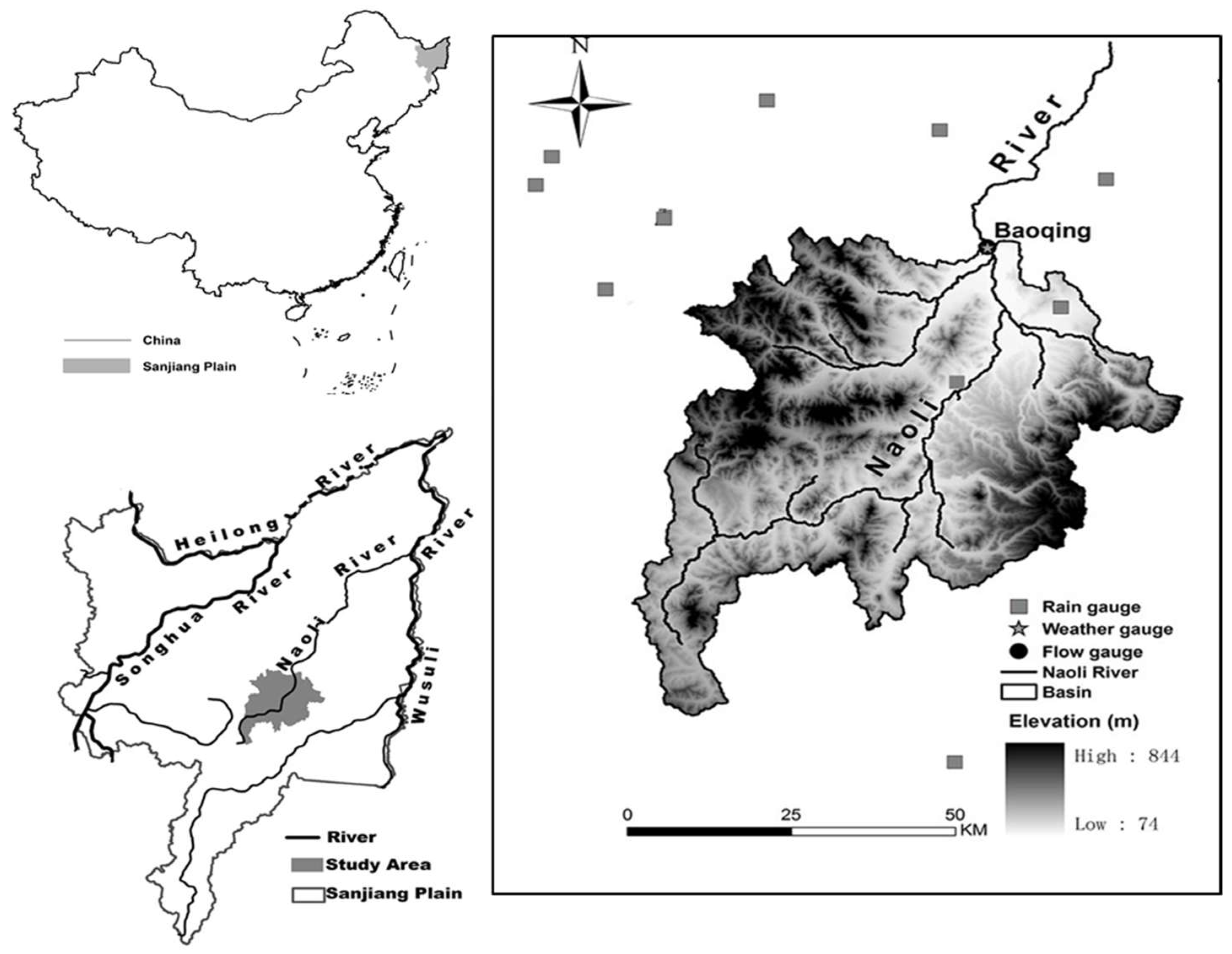
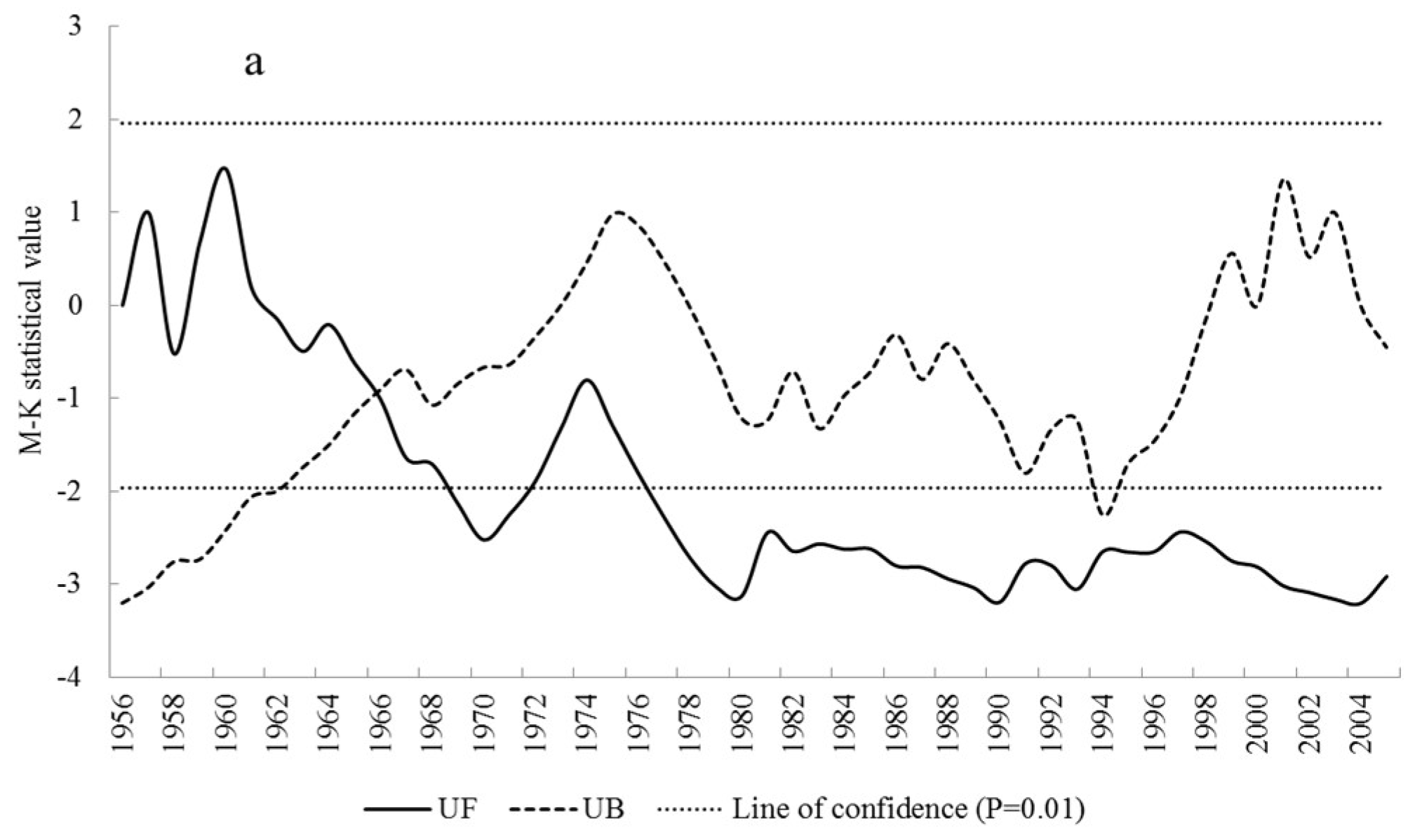
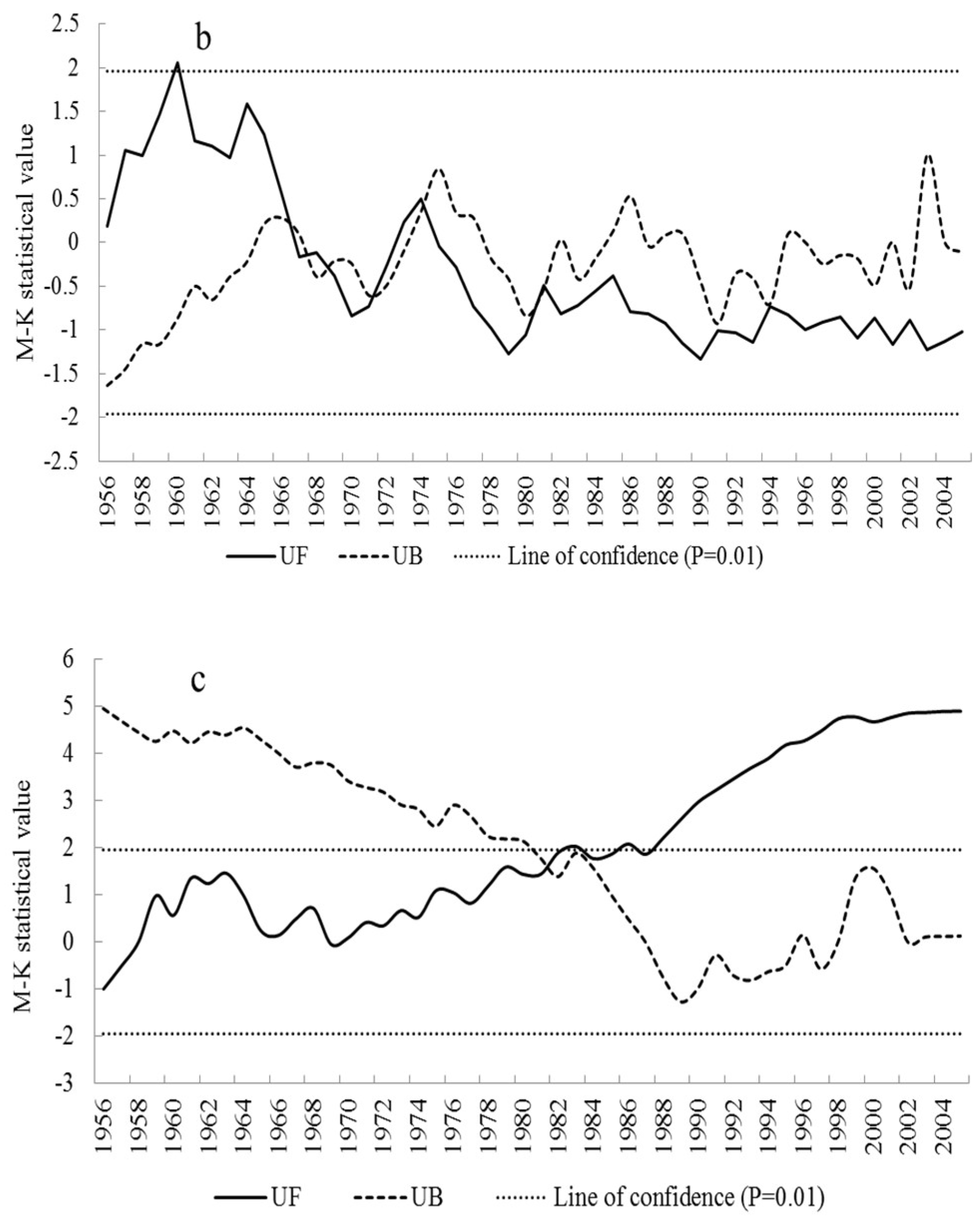
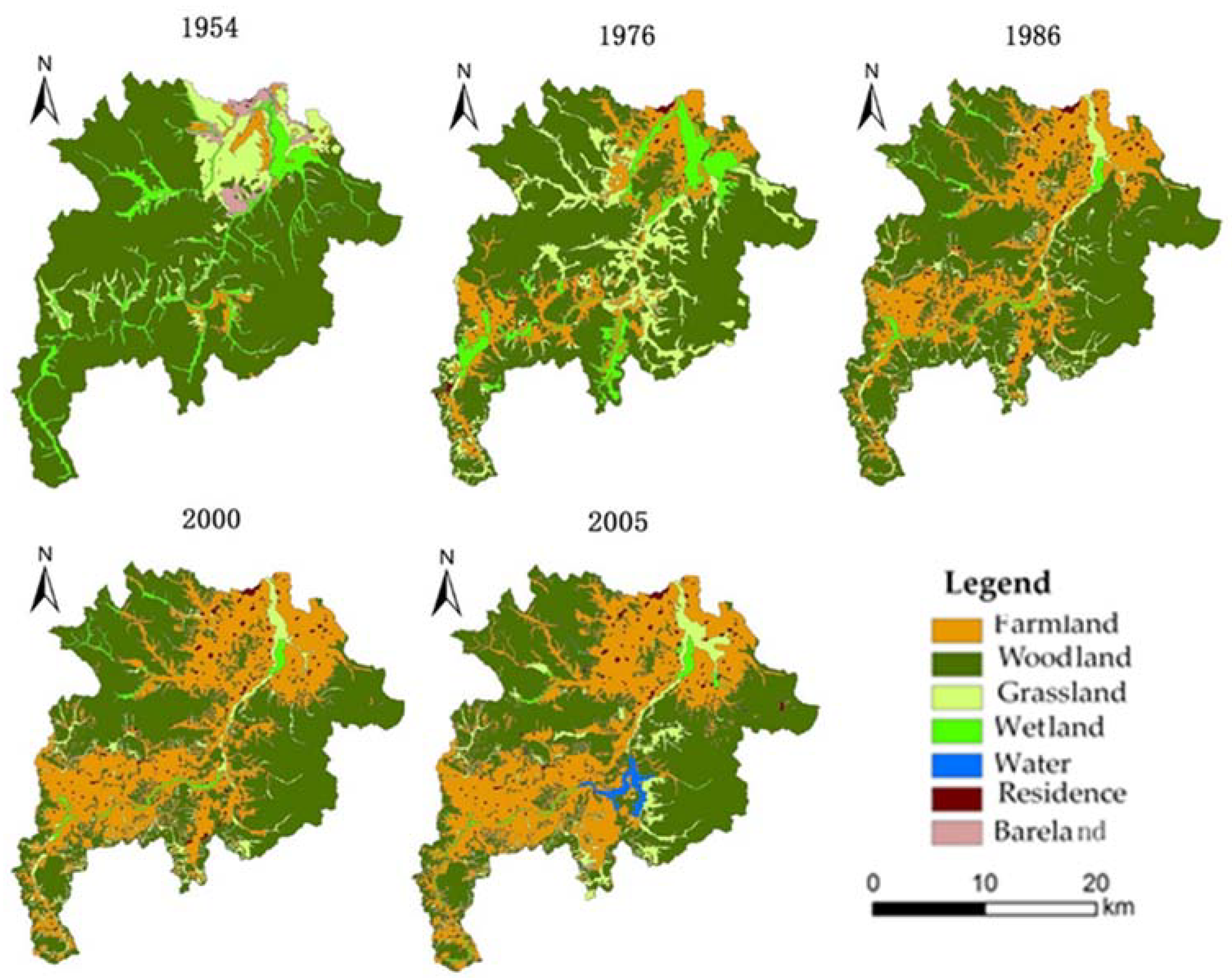
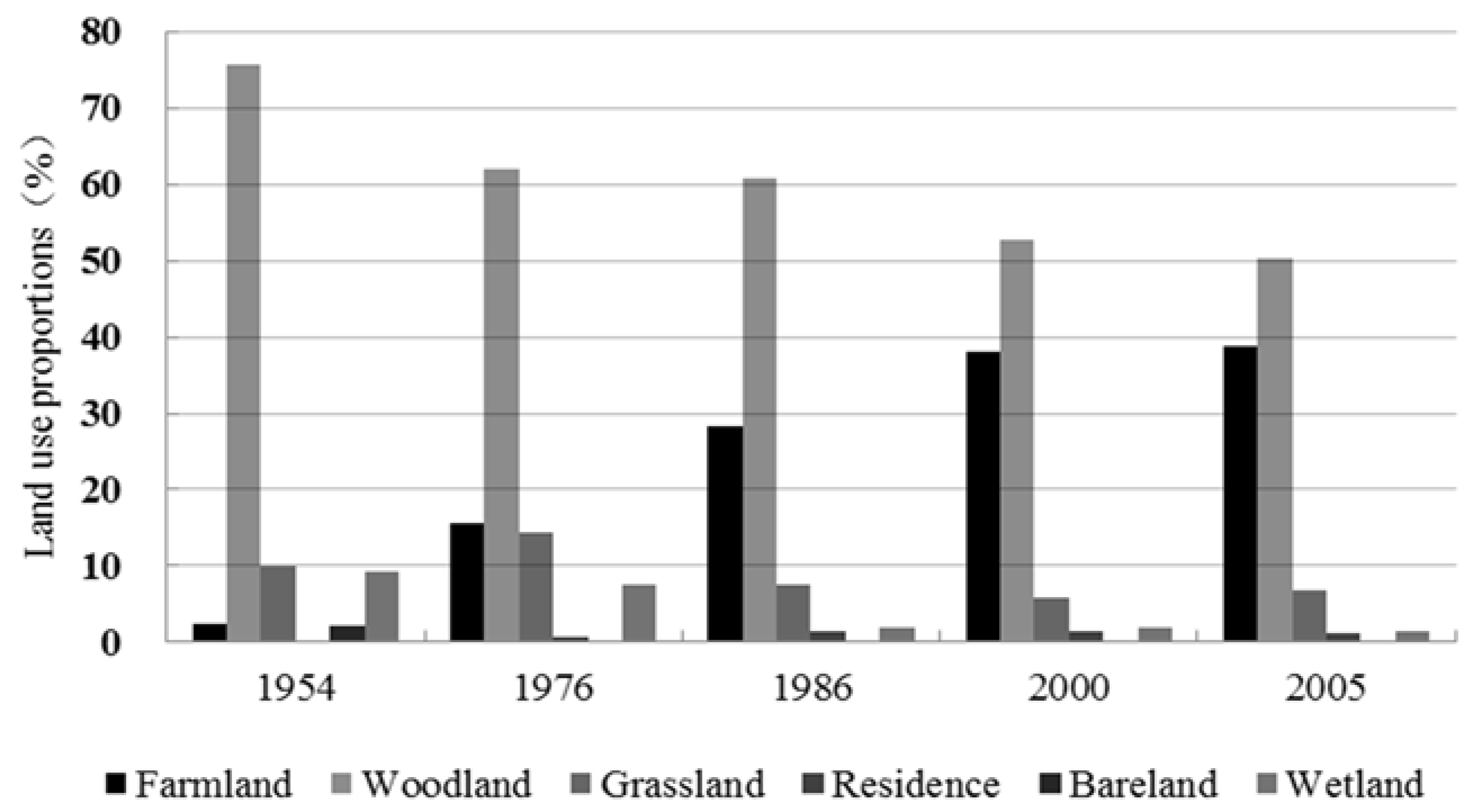
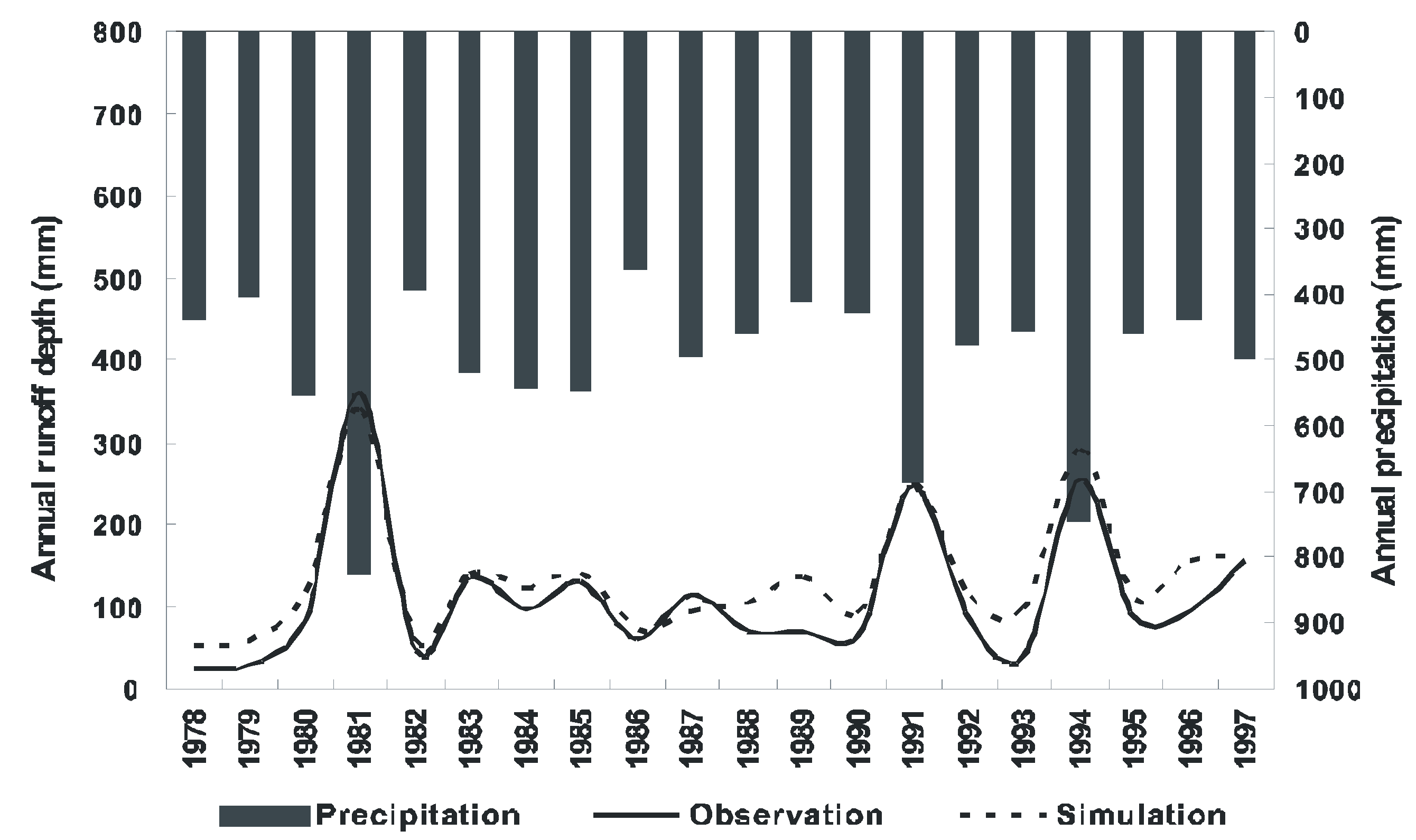
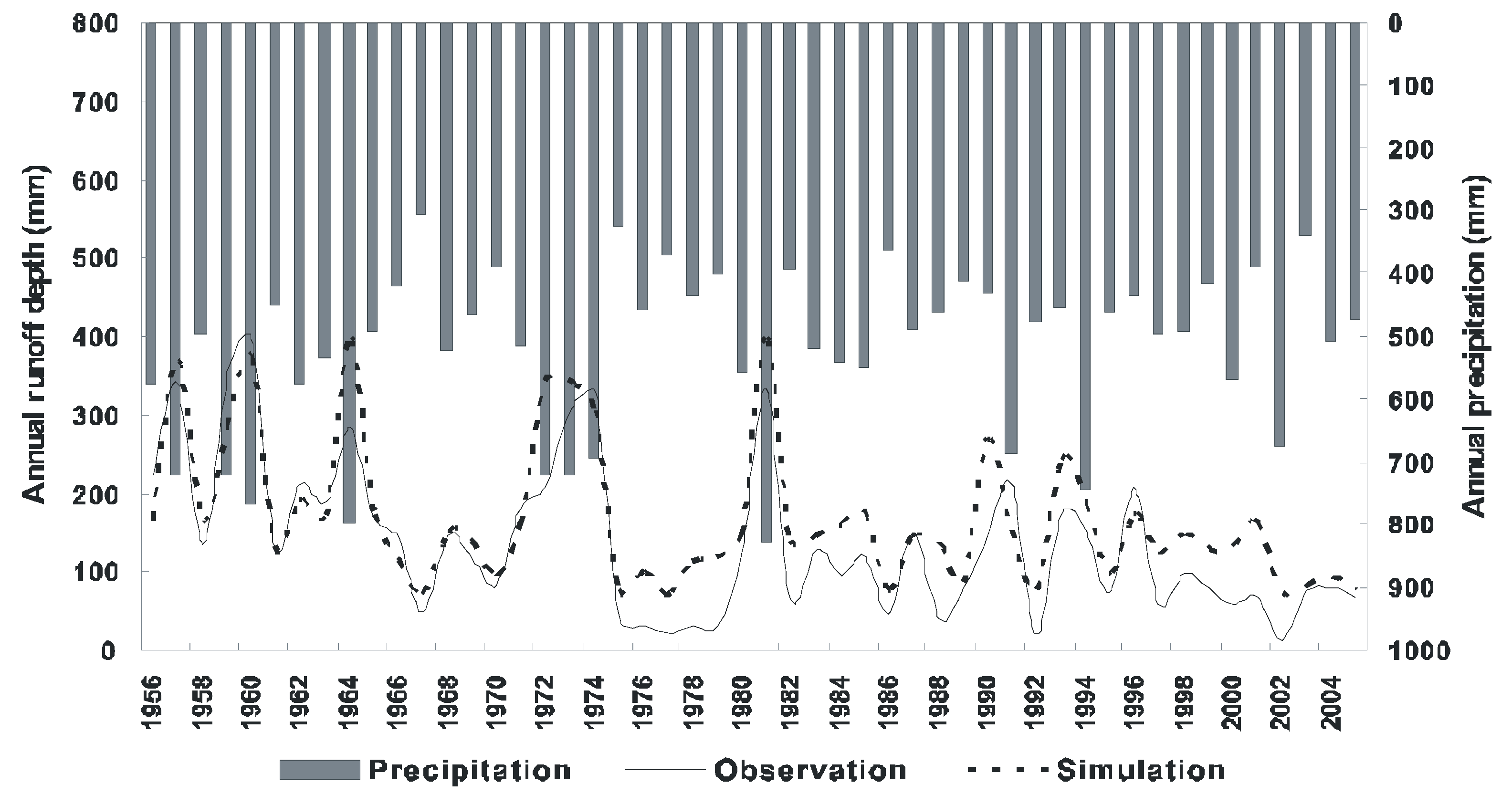
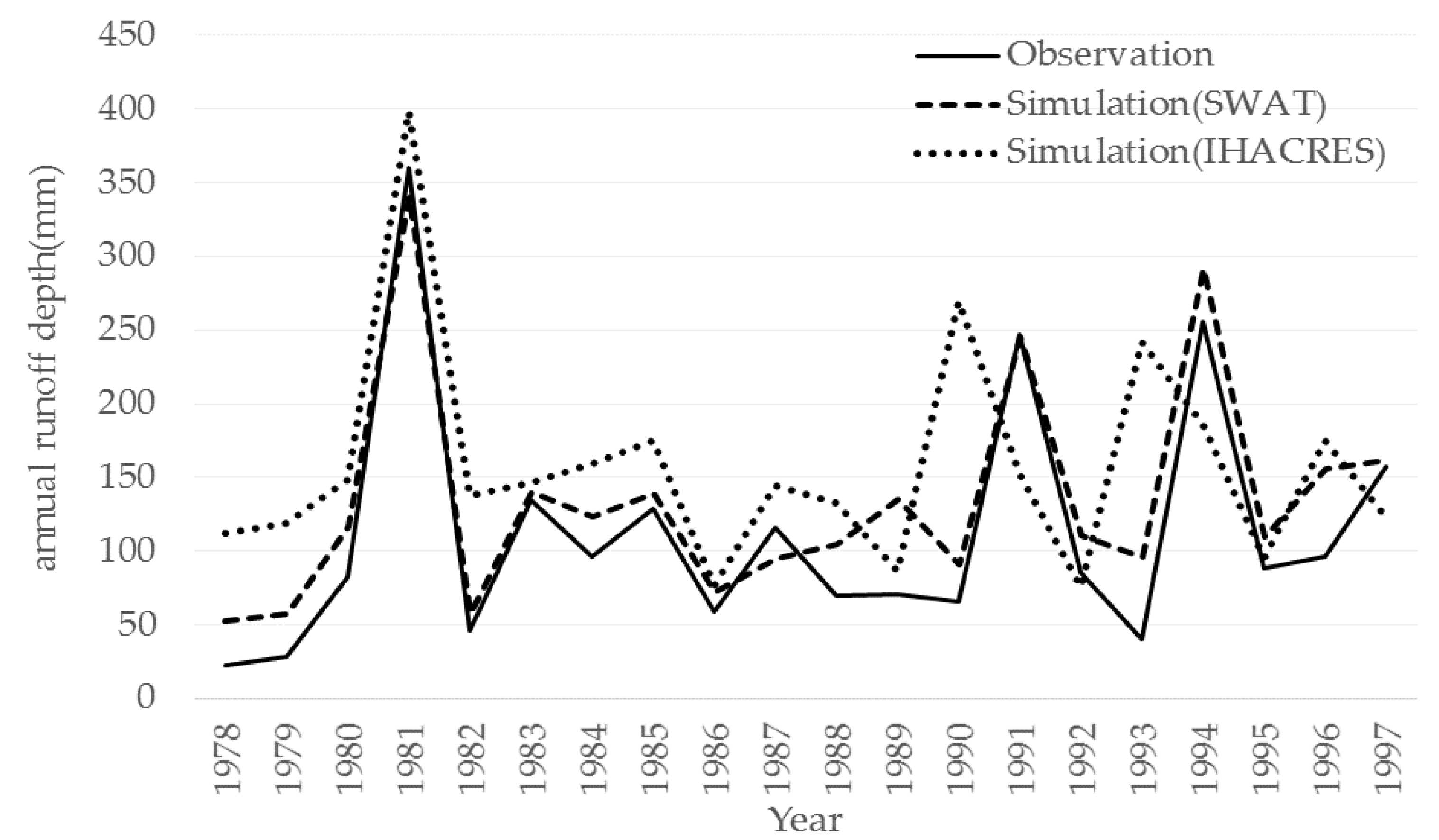
| Meteorologic and Runoff Elements | 1956–1966 | 1967–2005 | ||||
|---|---|---|---|---|---|---|
| Z | β | H0 | Z | β | H0 | |
| Rain (mm) | −1.640 | −1.780 | Accept | 0.073 | −0.862 | Accept |
| Temperature (°C) | 4.448 | 0.042 | Reject | 2.915 | 0.036 | Reject |
| Runoff depth (mm) | −3.313 | −2.670 | Reject | −0.823 | −1.308 | Accept |
| Parameter | Description | Default | Optimal Value |
|---|---|---|---|
| CN2 | SCS runoff curve number for moisture condition II | 60–87 | 70–102 |
| ALPHA_BF | Base flow recession constant | 0.048 | 0.17 |
| ESCO | Soil evaporation compensation factor | 0.95 | 0.97 |
| CANMX | Maximum canopy storage | 0 | 1.38 |
| SOL_AWC | Available water capacity of the soil layer | 0.13–0.18 | 0.16–0.22 |
| SOL_Z | Depth from soil surface to bottom of layer | 120–250 | 128–267 |
| SURLAG | Surface runoff lag time | 4 | 1.16 |
| CH-K2 | Effective hydraulic conductivity in main channel alluvium | 0 | 58.44 |
| Parameter | Description | Default | Optimal Value |
|---|---|---|---|
| w | Drying rate at reference temperature | 2–30 | 2 |
| f | Temperature dependence of drying rate | 0–4 | 2.1 |
| c | A parameter calculated so that the volume of effective rainfall is equal to the total flow for the calibration period | 0 | 0.056 |
| tr | Reference temperature | 20 | 17 |
| δ | Time delay for flow response | 1 | 0 |
| Model | Periods | Performance Evaluation Criteria | ||
|---|---|---|---|---|
| R2 | NS | PBIAS | ||
| SWAT | 1988–1997 | 0.97 | 0.89 | 0.17 |
| 1978–1987 | 0.97 | 0.94 | 0.11 | |
| IHACRES | 1956–1966 | 0.78 | 0.72 | −0.02 |
| 1967–2005 | 0.77 | 0.70 | 0.26 | |
| 1988–1997 | 0.73 | 0.58 | −0.22 | |
| 1978–1987 | 0.81 | 0.62 | −0.35 | |
© 2018 by the authors. Licensee MDPI, Basel, Switzerland. This article is an open access article distributed under the terms and conditions of the Creative Commons Attribution (CC BY) license (http://creativecommons.org/licenses/by/4.0/).
Share and Cite
Liu, G.; He, Z.; Luan, Z.; Qi, S. Intercomparison of a Lumped Model and a Distributed Model for Streamflow Simulation in the Naoli River Watershed, Northeast China. Water 2018, 10, 1004. https://doi.org/10.3390/w10081004
Liu G, He Z, Luan Z, Qi S. Intercomparison of a Lumped Model and a Distributed Model for Streamflow Simulation in the Naoli River Watershed, Northeast China. Water. 2018; 10(8):1004. https://doi.org/10.3390/w10081004
Chicago/Turabian StyleLiu, Guihua, Zhiming He, Zhaoqing Luan, and Shuhua Qi. 2018. "Intercomparison of a Lumped Model and a Distributed Model for Streamflow Simulation in the Naoli River Watershed, Northeast China" Water 10, no. 8: 1004. https://doi.org/10.3390/w10081004
APA StyleLiu, G., He, Z., Luan, Z., & Qi, S. (2018). Intercomparison of a Lumped Model and a Distributed Model for Streamflow Simulation in the Naoli River Watershed, Northeast China. Water, 10(8), 1004. https://doi.org/10.3390/w10081004





